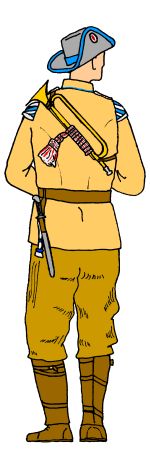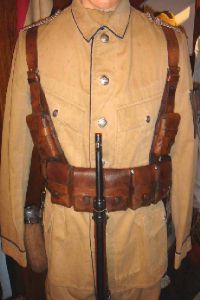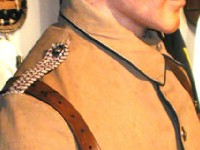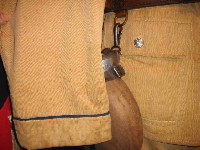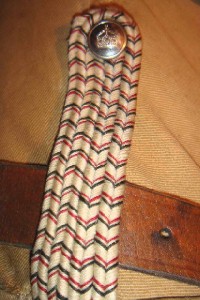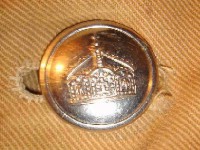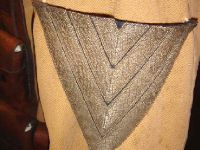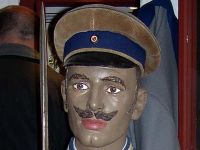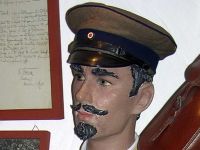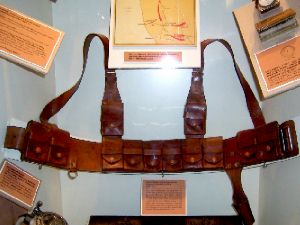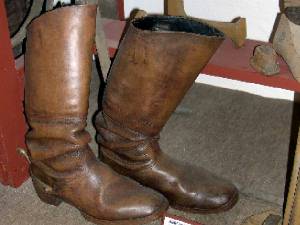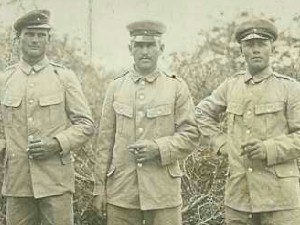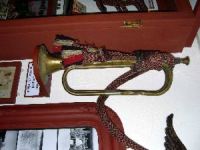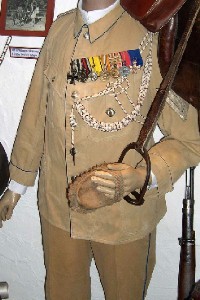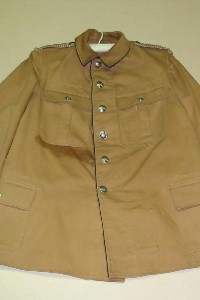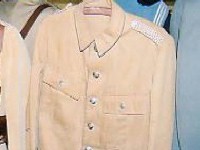Khaki tropical uniforms were first worn by the Schutztruppe's ancestor, the Truppe Des Reichs-Kommissars in South West Africa from 1891. Several modifications were made to the tunic before the regulations of 19th November 1896 introduced a new single khaki uniform for the Schutztruppe of South West Africa, East Africa and Cameroon. The new uniforms did not replace the old 1891 and 1894 khaki uniforms in South West Africa overnight however and period photographs show the old tunics were still in occasional use for several years to come. The 1896 khaki uniform continued to be worn on active service in hot weather in South West Africa until the First World War. No further alternations were made to it in the official regulations.
Tunic The shoulder straps were of twisted black/white/red braid for NCOs and other ranks. NCO rank insignia was displayed in the form of inverted chevrons on the upper left arm (see NCO Rank Insignia Page). Officers displayed their rank insignia on their shoulder straps in the usual manner (see Officers Rank Insignia Page). Parade aiguillettes, marksmanship lanyards, musicians swallows nests and other specialist insignia were all worn on the khaki uniform (see Specialist Insignia Page). Privately tailored uniforms purchased by officers, senior NCOs and One Year Volunteers were usually of better quality material and cut. They often had higher collars and occasionally had more major variations in cut such as having smaller pockets, scalloped pocket flaps or eight rather than six buttons down the front. One very interesting Schutztruppe tunic in a private collection has been seen in the cut of the 1896 khaki uniform but made from corduroy and with buttoned Swedish style cuffs. There seems to have been some confusion over the style of cuff defined in the regulations of 1896. The original text describes a Swedish cuff, which usually means one with a piped turn-back cuff held by two horizontally placed buttons. However the next page of the uniform regulations where the tunic buttons are described does not mention buttons for the cuff. It seems that the vast majority of uniforms therefore did not have the cuff buttons but occasional privately purchased tunics did. The uniform was also illustrated at the time by the military artist Moritz Ruhl with cuff buttons (see Illustrated Plates Page).
Trousers Headdress The corduroy peaked Field Cap was also commonly worn with the khaki uniform. A grey cloth peaked cap to match the grey Home Uniform was authorised in 1897 and was sometimes worn in South West Africa too. Both caps had hatband and piping in colony colours (blue for South West Africa), a small imperial cockade at the front and a black leather peak (see Field Caps Page). They were issued with a wire retaining loop that held the shape of the top of the hat. This loop was often removed to give a more comfortable appearance. Tropical helmets were not worn by the Schutztruppe in South West Africa after the early 1890s.
Footwear Equipment Officers were authorised to wear a white metallic lace belt with stripes in red and black as worn with the Home Uniform. On active service many officers carried a brown leather Sam Brown style belt. Weapons Officers did not usually carry their swords along the with the khaki uniform on active service. Period photographs show they were usually armed only with a pistol, although some carried a carbine like the other ranks to make them less conspicuous to enemy snipers.
The Illustrations Figure 1 is based on a photograph of an NCO of the South West African Schutztruppe taken escorting South African prisoners of war captured at the Battle of Sandfontein in 1914. He is typical of the appearance of South West African Schutztruppe before and during the First World War in hot weather. He wears the standard other ranks 1896 khaki Feldrock and trousers with Südwester hat. Note the three chevrons on his upper left arm denoting his rank as Vizefeldwebel (see NCO Rank Insignia Page). He wears the later third pattern of Schutztruppe mounted Equipment with buttoned ammunition pouches and riding boots all in natural brown leather. Figure 2 is based on a photograph of a Bugler of the South West African Schutztruppe taken while on parade in South West Africa. He again wears the 1896 khaki Feldrock (note the plain rear of the tunic) and brown corduroy riding breeches. German Schutztruppe musicians wore the traditional imperial army swallows nests on their shoulders in silver on blue, with a fringe for band masters. Buglers from mounted units (as shown here) wore swallows nests with the stripes at a 60 degree slope (see Specialist Insignia Page). He wears brown ankle boots with leather gaiters which were sometimes worn instead of riding boots. He also carries a kS98 bayonet in its steel scabbard, with a bayonet knot in company colours. The bayonet knot for other ranks of the South West African Schutztruppe was made in different colours for each Feldkompagnie. It is impossible to be certain of the colours from the original black and white photograph, I have coloured it blue and white for the 4. Feldkompagnie. NCOs wore bayonet knots in twisted black/white/red wool. Senior NCOs and officers wore sword knots in twisted black/silver/red.
Figure 3 is based on a photograph of an Officer of the South West African Schutztruppe serving on the staff of Oberstleutnant von Heydebreck (the commander of the Schutztruppe for South West Africa from 1911-14) taken on training manoeuvres in 1913. He wears a privately purchased officers 1896 khaki Feldrock, which were usually of better quality and cut than those of the other ranks. His rank is displayed on his shoulder straps (see Officers Rank Insignia Page). This officer wears the corduroy peaked field cap with a hatband and piping around the upper edge in cornflower blue for South West Africa and a small imperial cockade at the front. Unusually this officer wears puttees with short ankle boots (it is impossible to be certain from the original photograph upon which this illustration is based what colour his puttees may have been. I have coloured them grey, as worn by East African Schutztruppe of the period). Riding boots or short boots with gaiters were more normally worn by the Schutztruppe in South West Africa. Quite typically for active service this officer wears a Sam Brown style belt in brown leather and carries binoculars. Figure 4 is based on a photograph of a Officer of the South West African Schutztruppe, Hauptmann von Estorff probably taken during the Herero Rebellion 1904-07, and is typical of how Schutztruppe officers appeared on campaign up until 1915. As with the previous figure, his uniform is the same as that of the other ranks, except of better quality cloth with a higher standing collar and officers braided shoulder straps with two pips for a Hauptmann (see Officers Rank Insignia Page). He wears an officers Südwester hat (similar to those of the other ranks but of typically privately made and of higher quality and with a more elaborate cockade showing a white metallic, rather than plain white middle ring). He wears corduroy riding breeches with short boots and gaiters as usually worn by officers in the field. Again like the previous figure, he wears a Sam Brown style belt, this time with a pistol holster. Ludwig von Estorff (1859-1943) served in the 31st Thüringian Infantry Regt ("1. Thüringischen Infanterie-Regiment Nr. 31") before transferring to the Schutztruppe from 1894-1911. He served in the colonial office in Germany and briefly in East Africa, but spent most of his time in South West Africa, serving throughout the Herero and Nama Rebellions. After the defeat of the Herero at the Battle of Waterberg in 1904, he tried to accept the surrender of some of the rebels promising to resettle them peacefully, but was over-ruled by the then Schutztruppe commander Lothar von Trotha who ordered them to be interned as part of his notorious drive against the rebellious tribes. Hauptmann von Estorff was initially a company commander but was promoted to Major in 1906 and Oberst in command of the Schutztruppe of South West Africa from 1907 until his retirement back to Germany in 1911. During the First World War he was wounded in September 1914 while in command of the 68th Infantry Brigade on the Western Front, was awarded the Pour Le Merite in 1917 and eventually briefly commanded the 8th Army Group as Military Governor of Königsberg (modern Kalingrad) on the Eastern Front. Figure 5 is based on a photograph of a Schutztruppe Trooper ("Reiter") in shirt-sleeve order probably taken during the latter part of the Herero Rebellion 1904-07. The climate of South West Africa went from extremes of hot and cold. In hot weather the Schutztruppe are often seen in period photographs in shirtsleeve order on campaign. The shirt is the standard issue white shirt usually worn under the tunic. This trooper also wears the corduroy peaked field cap with piping and hatband in blue for South West Africa and a small black/white/red imperial cockade on the front, Schutztruppe khaki trousers and riding boots.
|
|||||||||||||||||||||||||||||||||||||||||||||||||||||||||||||||||||||||||||||||||||||||||||||||||||

